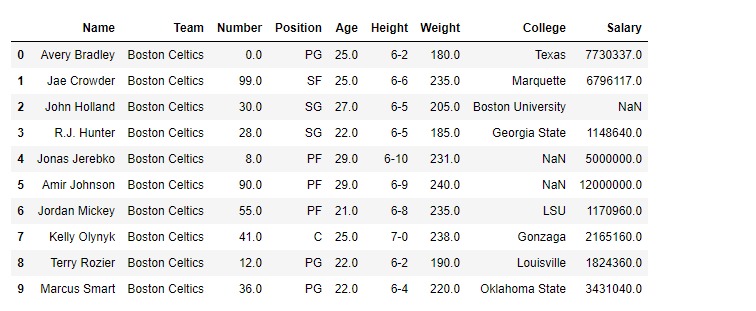Python是進行數據分析的一種出色語言,主要是因為以數據為中心的Python軟件包具有奇妙的生態係統。 Pandas是其中的一種,使導入和分析數據更加容易。
Dataframe.aggregate()函數用於在一個或多個列上應用某些聚合。使用callable,string,dict或string /callables列表進行聚合。最常用的聚合是:
sum:返回所請求軸的值之和
min:返回所請求軸的最小值
max:返回所請求軸的最大值
用法: DataFrame.aggregate(func, axis=0, *args, **kwargs)
參數:
func:可調用,字符串,字典或字符串/可調用列表。用於匯總數據的函數。如果是函數,則必須在傳遞DataFrame或傳遞給DataFrame.apply時起作用。對於DataFrame,如果鍵是DataFrame列名,則可以傳遞dict。
axis:(默認0){0或“索引”,1或“列”} 0或“索引”:將函數應用於每個列。 1或“列”:將函數應用於每一行。
返回:聚合的DataFrame
有關在代碼中使用的CSV文件的鏈接,請單擊此處
範例1:匯總 DataFrame 中所有列的“和”和“最小”函數。
# importing pandas package
import pandas as pd
# making data frame from csv file
df = pd.read_csv("nba.csv")
# printing the first 10 rows of the dataframe
df[:10]
聚合僅適用於數字類型的列。
# Applying aggregation across all the columns
# sum and min will be found for each
# numeric type column in df dataframe
df.aggregate(['sum', 'min'])輸出:
對於具有數值的每一列,已找到所有值的最小值和總和。對於 DataFrame df,我們有四個這樣的列:數字,年齡,體重,薪水。
範例2:
在Pandas中,我們還可以在不同的列上應用不同的聚合函數。為此,我們需要傳遞一個字典,該字典的鍵包含列名稱,值包含任何特定列的聚合函數列表。
# importing pandas package
import pandas as pd
# making data frame from csv file
df = pd.read_csv("nba.csv")
# We are going to find aggregation for these columns
df.aggregate({"Number":['sum', 'min'],
"Age":['max', 'min'],
"Weight":['min', 'sum'],
"Salary":['sum']})輸出:
單獨的聚合已應用於每個列,如果未在列上應用任何特定的聚合,則它具有與之對應的NaN值。

相關用法
- Python pandas.map()用法及代碼示例
- Python Pandas Series.str.len()用法及代碼示例
- Python Pandas.factorize()用法及代碼示例
- Python Pandas TimedeltaIndex.name用法及代碼示例
- Python Pandas dataframe.ne()用法及代碼示例
- Python Pandas Series.between()用法及代碼示例
- Python Pandas DataFrame.where()用法及代碼示例
- Python Pandas Series.add()用法及代碼示例
- Python Pandas.pivot_table()用法及代碼示例
- Python Pandas Series.mod()用法及代碼示例
- Python Pandas Dataframe.at[ ]用法及代碼示例
- Python Pandas Dataframe.iat[ ]用法及代碼示例
- Python Pandas.pivot()用法及代碼示例
- Python Pandas dataframe.mul()用法及代碼示例
- Python Pandas.melt()用法及代碼示例
注:本文由純淨天空篩選整理自Shubham__Ranjan大神的英文原創作品 Python | Pandas dataframe.aggregate()。非經特殊聲明,原始代碼版權歸原作者所有,本譯文未經允許或授權,請勿轉載或複製。
